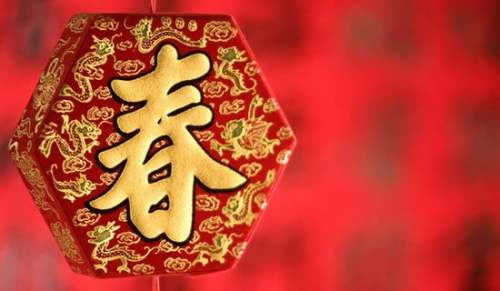春節的起源英語
春節是中國最富有特色的傳統節日。它標志農歷舊的一年結束。以下是小編為您整理的春節的起源英語相關資料,歡迎閱讀!

關于中國春節的由來
春節,是農歷的歲首,也是我國古老的.傳統節日。古代過“年”不是在臘月二十九日或三十日,而是在“蠟日”,即后來的“臘八”。南北朝以后,把“蠟祭”移至歲末。到了民國時 ,改用陽歷,才把陰歷年叫“春節”,因為春節一般都在“立春”前后。
春節是我國最盛大、最熱鬧的一個古老傳統節日。俗稱“過年”。按照我國農歷,正月初一古稱元日、元辰、元正、元朔、元旦等,俗稱年初一,還有上日、正朝、三朔、三朝、三始、三元等別稱,意即正月初一是年、月、日三者的開始。
春節,顧名思義就是春天的節日。春天來臨,萬象更新,新一輪播種和收獲季節又要開始。 人們有足夠的理由載歌載舞來迎接這個節日。于是,節前就在門臉上貼上紅紙黃字的新年寄語。
春節的另一名稱叫過年。“年”是什么呢?是一種為人們帶來壞運氣的想象中的動物。“年”一來。樹木凋蔽,百草不生;“年”一“過”,萬物生長,鮮花遍地。“年”如何才能過去呢?需用鞭炮轟 ,于是有了燃鞭炮的習俗。1993年,北京市人民政府頒布了禁放煙花爆竹的法律,使這一沿續了幾百年的習俗成為歷史。
春節是個親人團聚的節日,這一點和西方的圣誕節很相似。離家的孩子這時要不遠千里回到父母家里。真正過年的前一夜叫“除夕”,又叫“團圓夜”,“團年”。傳統的慶祝活動則從除夕一直持續到正月十五元宵節。喜慶氣氛要持續一個月。 正月初一前有祭灶、祭祖、 掃除污穢。三十日要貼門神、對聯、掛旗、吃餃子、放鞭炮,除夕“守歲”等 儀 式;正月初一晚輩向長輩拜年,然后至親友家賀年。親友第一次見面時,說些“恭賀新喜”、“恭喜發財”、“恭喜”、“過年好”等話,互相祝賀。
The Origin of Chinese New Year
The Chinese New Year is now popularly known as the Spring Festival because it starts from the Begining of Spring (the first of the twenty-four terms in coodination with the changes of Nature). Its origin is too old to be traced. Several explanations are hanging around. All agree, however, that the word Nian, which in modern Chinese solely means "year", was originally the name of a monster beast that started to prey on people the night before the beginning of a new year.
One legend goes that the beast Nian had a very big mouth that would swallow a great many people with one bite. People were very scared. One day, an old man came to their rescue, offering to subdue Nian. To Nian he said, "I hear say that you are very capable, but can you swallow the other beasts of prey on earth instead of people who are by no means of your worthy opponents?" So, it did swallow many of the beasts of prey on earth that also harrassed people and their domestic animals from time to time.
After that, the old man disappeared riding the beast Nian. He turned out to be an immortal god. Now that Nian is gone and other beasts of prey are also scared into forests, people begin to enjoy their peaceful life. Before the old man left, he had told people to put up red paper decorations on their windows and doors at each year's end to scare away Nian in case it sneaked back again, because red is the color the beast feared the most.From then on, the tradition of observing the conquest of Nian is carried on from generation to generation. The term "Guo Nian", which may mean "Survive the Nian" becomes today "Celebrate the (New) Year" as the word "guo" in Chinese having both the meaning of "pass-over" and "observe". The custom of putting up red paper and firing fire-crackers to scare away Nian should it have a chance to run loose is still around. However, people today have long forgotten why they are doing all this, except that they feel the color and the sound add to the excitement of the celebration.
春節歷法
Intercalary Spring Festival
After Spring Festival, also known as intercalary month, beginning in 1645 using the calendar fall, in 2800 1155, in the first month of the lunar leap occurs only 6 times, is very rare, the year were 1651, 2262, 2357, 2520, 2539, 2634.
The crossing method of the leap Spring Festival
If a year is a leap positive month, the first month of the Spring Festival is on the first month of the spring. Of course, there are also a few areas that have passed the first Spring Festival after the first lunar month. When they arrived at the beginning of the lunar calendar, they also passed the Spring Festival of the first lunar month, because the lunar month is also called the first lunar month. This is all understandable.
The earliest and the latest
The Spring Festival travels between January 21st and February 21st of the Gregorian calendar. Spring is usually in February 4th or February 5th. "The earliest Spring Festival" (such as January 21st in 1966) and "the latest Spring Festival" (such as February 20th in 1985) are a whole month.
According to calendar calculation, if the lunar calendar is not adjusted artificially, February 21, 2319 will usher in the "latest Spring Festival". The latest Spring Festival appeared in the Gregorian calendar February 20th, 1920 and 1985.
【春節的起源英語】相關文章:
光棍節起源英語09-28
手抄報資料:春節的起源及由來08-08
粵語的起源09-13
粽子的起源08-12
況姓的起源06-30
公冶姓的起源06-29
徹姓的起源06-09
穆的姓氏起源07-20
臣姓的起源07-21
湛的姓氏起源07-20